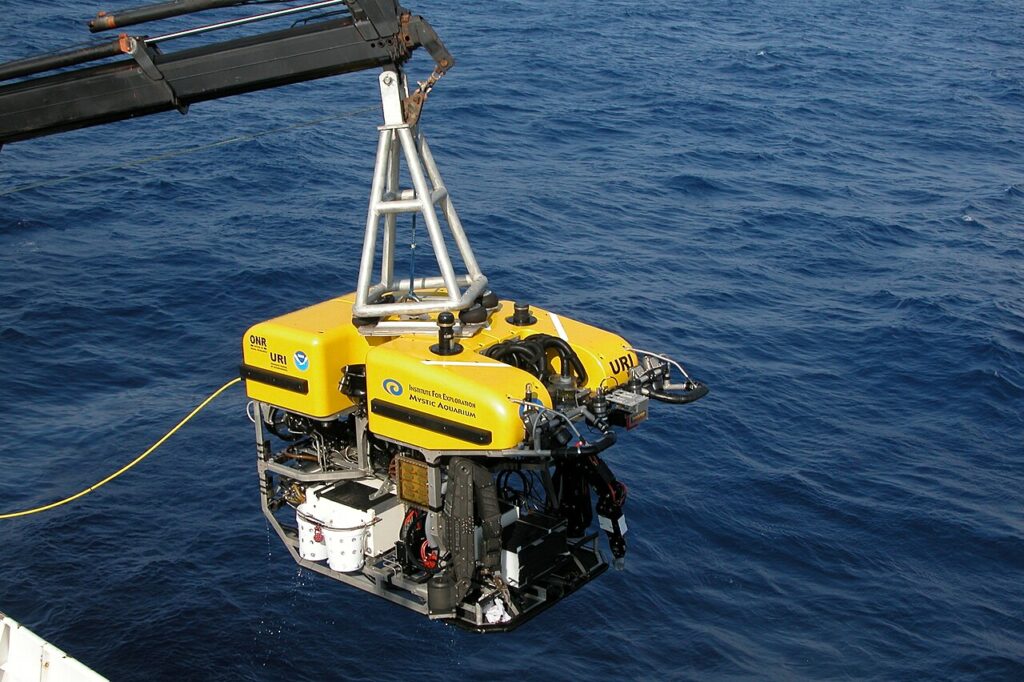Remotely Operated Vehicles, or ROVs for short. These adaptable underwater robots are primarily used for deep-sea exploration, inspection, and other tasks in environments that are either too hazardous or inaccessible for human divers and are controlled remotely by operators.
So how do ROV’s work :
ROVs are basically tethered robots that can be controlled from above, usually from a ship or a platform. The tether is used for a number of things: it gives the ROV power, lets it talk to the operator, and sometimes even sends data back to the control station. These ties are typically made areas of strength for of, materials that can endure the cruel states of remote ocean conditions, including high tensions and low temperatures.
The frame, thrusters, cameras, sensors, and a variety of manipulators or tools are the ROV’s primary components. In order to ensure durability while reducing weight, the frame is typically constructed of lightweight materials like titanium or aluminum.

What do ROV’s use
The ROV’s thrusters are its propulsion system, allowing it to move in any direction—forward, backward, up, down—and rotate. The number and arrangement of engines can change contingent upon the particular plan and expected utilization of the ROV. Any ROV needs cameras because they give the operator visual feedback. Operators are able to see clearly in the often murky and dark underwater environment thanks to high-definition cameras and powerful lighting systems. ROVs have depth sensors, sonar systems for avoiding obstacles and navigation, chemical sensors for environmental monitoring, and a variety of other sensors in addition to cameras.

Numerous ROVs also have manipulators, also known as robotic arms, which enable them to interact with their surroundings. These arms can be used to cut cables, collect samples, and make repairs, among other things. These manipulators can have a wide range of precision and dexterity, from simple grabbers to highly articulated multi-jointed arms. ROVs come in a variety of sizes and are made to do different things.
Little ROVs, frequently alluded to as perception class ROVs, are ordinarily utilized for visual examination and straightforward undertakings. They are smaller, less expensive, and easier to deploy than their larger counterparts. Work-class ROVs, on the other hand, are larger, more powerful, and equipped with cutting-edge tools and sensors for heavy-duty exploration, construction, and repair. These vehicles are utilized in a large number of enterprises and applications. ROVs are essential for inspecting underwater pipelines, rigs, and other infrastructure in the oil and gas industry.
Additionally, they are utilized for the laying of cables, inspection and upkeep of offshore wind farms, and environmental impact assessments. In sea life science, ROVs empower researchers to investigate remote ocean biological systems, gather tests, and review marine life in their regular living spaces without the requirement for monitored subs. ROVs’ capabilities are also beneficial to search and rescue operations.
They can be used to search for and recover bodies or objects from underwater accident sites like shipwrecks or downed aircraft. They are invaluable in situations where human divers would face significant risks due to their ability to operate in extreme conditions. Underwater surveillance, mine detection, and removal are examples of applications in the military and defense sectors. ROVs are utilized to review the frames of boats for possible dangers, study submerged designs, and even aid hostile to submarine fighting tasks.
The exploration of the Titanic wreck was one of the most well-known applications of ROVs. ROVs were used to navigate the complex and dangerous environment around the sunken ship in the late 20th and early 21st centuries, providing high-resolution images and videos that would have been impossible to obtain otherwise.
The advancements in robotics, artificial intelligence, and materials science are driving the ongoing development of ROV technology. ROVs of today are becoming more and more self-sufficient, able to complete challenging tasks with little assistance from humans. The reconciliation of man-made intelligence permits these vehicles to handle information progressively, pursuing choices in light of sensor data sources, and in any event, gaining from their current circumstance.
All in all, ROVs are adaptable, remotely worked machines intended to perform errands in submerged conditions that are excessively dangerous or unrealistic for people. Oil and gas, marine biology, search and rescue, and defense are just a few of their many uses. ROVs continue to improve in capability and autonomy as technology advances, presenting new opportunities for underwater exploration and operations.
